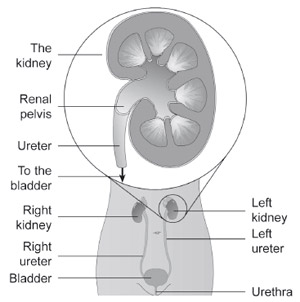Kidney Cancer - Renal Cell Carcinoma
What Is Kidney Cancer (Adult) - Renal Cell Carcinoma?
Kidney cancer is a cancer that starts in the kidneys. To understand more
about kidney cancer, it helps to know about the normal structure and function of the kidneys.
About the kidneys
The kidneys are a pair of bean-shaped organs, each about the size of a fist and weighing about 4 to 5 ounces
. They are fixed to the upper back wall of the abdominal cavity. One kidney is just to the left and the other
just to the right of the spine. Both are protected by the lower ribcage.The kidneys' main job is to filter
blood and rid your body of excess water, salt, and waste products. The filtered waste products are concentrated
into urine. Urine leaves the kidneys through long slender tubes called ureters that connect to the bladder.
Urine flows down the ureters into the bladder, where it is stored until you urinate.
The kidneys also help make sure the body has enough red blood cells. It does this by making a hormone
called erythropoietin, which tells the bone marrow to make more red blood cells.
Although our kidneys are important, we actually need less than one complete kidney to function. Tens
of thousands of people in the United States are living normal healthy lives with just one kidney.
Some people may not have any working kidneys at all, and survive with the help of a medical procedure
called dialysis. Dialysis uses a specially designed machine that acts like a real kidney to filter
the blood.

Renal cell carcinoma
Renal cell carcinoma (RCC), also known as renal cell cancer or renal cell adenocarcinoma, is by far
the most common type of kidney cancer. It accounts for about 9 out of 10 kidney cancers.
Although RCC usually grows as a single mass within the kidney, sometimes tumors are found in more
than one part of the kidney or even in both kidneys at the same time. Some renal cell carcinomas are
noticed only after they have become quite large, but most are found before they metastasize (spread)
to distant organs in the body. Often they are found on CT scans or ultrasounds being done for concerns
other than kidney cancer. Like most cancers, RCC is hard to treat once it has metastasized.
There are several subtypes of RCC, based mainly on how the cancer cells look under a microscope:
Clear cell renal cell carcinoma
This is the most common form of renal cell carcinoma. About 8 out of 10 people with renal cell carcinoma
have this kind of cancer. When seen under a microscope, the cells that make up clear cell RCC appear
very pale or clear.
Papillary renal cell carcinoma
This is the second most common subtype -- about 10% to 15% of people have this kind. These cancers form
little finger-like projections (called papillae) in some, if not most, of the tumor. Some doctors call
these cancers chromophilic because the cells take in certain dyes used so the tissue can be seen under
the microscope, and look pink.
Chromophobe renal cell carcinoma
This subtype accounts for about 5% of RCCs. The cells of these cancers are also pale, like the clear
cells, but are much larger and have certain other features that can be recognized.
Collecting duct renal cell carcinoma
This subtype is very rare. The major feature is that the cancer cells can form irregular tubes
.
Unclassified renal cell carcinoma
In rare cases, renal cell cancers are labeled as unclassified because the way they look doesn't fit
into any of the other categories or because there is more than one type of cell present.
Other cancerous kidney tumors
Less common cancers of the kidney include transitional cell carcinomas, Wilms tumors, and renal
sarcomas.